Will high interest rates sink Colombia's housing market?
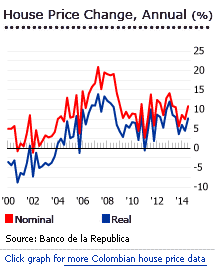 For the past ten years Colombia has had an unbroken trend of house price rises, which continued in early 2016. House and apartment prices rose by 15.08% (6.88% inflation-adjusted) during the year to Q1 2016, according to the Banco de la Republica Colombia (Banrep) index, which covers second-hand houses and apartments. During the latest quarter (Q1 2016), the index rose 6.07% (2.85% inflation-adjusted) from the previous quarter.
For the past ten years Colombia has had an unbroken trend of house price rises, which continued in early 2016. House and apartment prices rose by 15.08% (6.88% inflation-adjusted) during the year to Q1 2016, according to the Banco de la Republica Colombia (Banrep) index, which covers second-hand houses and apartments. During the latest quarter (Q1 2016), the index rose 6.07% (2.85% inflation-adjusted) from the previous quarter.
The Banrep house price index includes nine cities (the three major cities: Bogotá (the capital, with a population of 7.96 million), Medellin (pop: 3.5 million), and Cali (pop: 2.3 million), plus Barranquilla, Bucaramanga, Cucuta, Manizales, Neiva and Villavicencio).
Colombia’s property market has seen spectacular house price rises over the past ten years:
+ 14.31% (9.64% inflation-adjusted) in 2006
+ 16.72% (10.60% inflation-adjusted) in 2007
+ 18.01% (10.28% inflation-adjusted) in 2008
+ 10.56% (6.09% inflation-adjusted) in 2009
+ 6.91% (4.50% inflation-adjusted) in 2010
+ 8.29% (4.70% inflation-adjusted) in 2011
+ 11.48% (8.06% inflation-adjusted) in 2012
+ 9.91% (7.66% inflation-adjusted) in 2013
+ 8.25% (5.15% inflation-adjusted) in 2014
+ 10.33% (5.11% inflation-adjusted) in 2015
The new house price index compiled by the Departamento Administrativo Nacional de Estadística (DANE) tells a slightly different story. The price index of new houses was up by 6.83% during the year to Q1 2016. But when adjusted for inflation, prices were actually down by 0.79%. New apartment prices also rose by 6.89%, but were down by 0.73% in real terms.
And from the perspective of the foreign investor, things look very different indeed. Over the past two years the Colombian peso has nearly halved in value against the US$. Any dollar-based buyer is likely to have lost a lot of money.
Inflation on the rise

Inflation has been accelerating worryingly in Colombia, reaching 8.2% in May 2016, more than double the official 3% target. As a result, the Banco de la Republica Colombia (Banrep), Colombia's central bank, raised its key policy rate by 25 basis points to 7.5% in June 2016, the 10th consecutive month of rises. In June 2016, Colombia's prime lending rate rose to 14.77%, up from 10.98% in June 2015.
Finance Minister Mauricio Cardenas has hinted that the interest rate increases might end soon. "Interest rates have reached a fair, suitable level. A level that allows for an ordered adjustment in the economy, including slower inflation," said Cardenas.
Higher interest rates' impact on the housing market may remain low, because mortgage lending in Colombia remains low. Only 3% of the adult population have mortgages, according to Bancolombia, Colombia's largest bank, and outstanding mortgages amounted to only 6.34% of GDP in December 2015. The number of houses financed by mortgages declined by 8.48% in 2015.
How the main cities compare
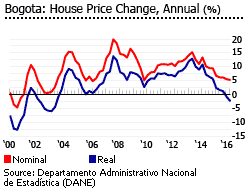
During the year to Q1 2016 Medellin had nominal new house price rises of 8.93% (1.16% inflation-adjusted), but in Colombia's two other major cities new house prices have declined, in real terms: in Cali new house prices rose by 6.08%, but were down by 1.49% in real terms; in Bogota new house prices increased by 5.31%, but were down by 2.2% in real terms. There were however price increases in other areas aside from the three major cities, including strong rises in Armenia, which had an 11.93% y-o-y increase in new house prices (3.95% inflation-adjusted), followed by Pereira with 11.32% (3.38% inflation-adjusted), and Bucaramanga with 10.38% (2.51% inflation-adjusted), according to DANE.
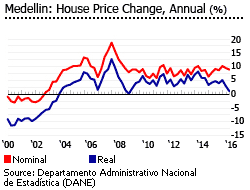
From 2006 to 2008, new house prices in Cali rose most strongly, by 42.95%, followed by Bogota (37.95%), and Medellin (24.85%). In 2009, Cali's new house prices plunged, while Bogota was static and Medellin continued to rise. In 2010, new house prices in both Bogota (10.51%) and Cali (4.54%) started recovering, while prices in Medellin slowed (5.84%).
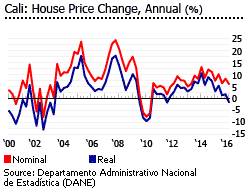
Since then, new house prices in these three major cities have remained buoyant. From 2011 to 2015, house prices in Bogota rose by 44.66%, followed by Cali (39.78%), and Medellin (38.97%).
Good to moderate rental yields
Gross rental yields in Bogota are moderate to good, according to the Global Property Guide's research of October 2014. Apartment yields range from 5.55% for 200 sq. m. apartments, to 6.98% for 120 sq. m. apartments in Chapinero Alto. In Chico, apartments yields range from 5.85% to 7.05%. Yields on apartments in Santa Barbara range from 6.38% to 6.43%.
Typical apartment costs in Bogota:
- Chapinero Alto – from US$ 143,850 (75 sq. m.) to US$ 493,800 (200 sq. m.)
- Chico – from US$ 189,150 (75 sq. m.) to US$ 525,800 (200 sq. m.)
- Santa Barbara – from US$ 158,400 (75 sq. m.) to US$ 385,600 (200 sq. m.)
Zika outbreak may affect tourism
Tourism is a rapidly growing sector of Colombia’s economy. From 1990 to 2015, the contribution of travel and tourism rose from 3.6% of GDP in 1990, to 6.1% of GDP in 2015, according to the World Travel and Tourism Council (WTTC). Tourist arrivals reached 1.138 million visitors in 2014, up 4.7% from the previous year. Most came from Europe (51.7%), followed by the Americas (15.9%), and Asia Pacific (23.1%), according to the World Tourism Organization (UNWTO).
The country’s selling points include: UNESCO World Heritage Sites in Cartagena; the surrounding areas of San Andres, Santa Marta, and Providencia y Santa Catalina; the Colombian coffee growing axis, which houses the popular cities of Armenia, Pereira, and Medellin; and the country’s capital, Bogota, which recently became more popular with tourists due to major urban renovations and rehabilitations and improved facilities and museums.
However, the spread of the Zika virus could reduce the number of tourist arrivals in 2016. According to the Centers for Disease Control and Prevention (CDC), around 30 countries have been affected by Zika, including Colombia. Colombia's total annual income from international tourists was around US$ 4.759 billion in 2013, one of the highest among the 30 affected countries.
The city of Cartagena (pop: 855,000), one of the country’s oldest colonial cities, is the city of most interest to many foreign buyers. Founded in 1533 by Spaniards, Cartagena was a trading port and a slave port where Africans were sold and shipped to other Latin American countries.
Cartagena is a large and intact colonial town of great beauty. The city has a port, fortresses, and monuments on the UNESCO World Heritage List. The revival of Cartagena’s historic centre occurred in early 2000s, when wealthy expatriate Colombians began to buy and restore run-down colonial buildings. This eventually drove prices up by as much as 300% to 600% (in some cases) from 2004 to 2009, according to Patrick Enste, general manager of the real estate company La Heroica.
Cartagena is now the most dynamic and most expensive property market in the country, aside from some parts of Bogota. “Good-quality apartments with unobstructed water views,” have home prices rising by around 5% to 10% a year according to Paul Juan, owner of the brokerage Paul Juan Realty. It is difficult to find a property within the historic centre priced below $1 million, According to Cartagena First Realty's Jim Main, and if there is one, it would be a house that needs renovation. Restored houses in the historic centre cost around COP 10 million per sq. m., or US$ 372 per sq. ft.
Bocagrande is also becoming popular among investors, because of its long beaches, shopping malls, high-rise hotels, and upscale apartment complexes.
“There is a scarcity of good-quality inventory, so construction is high right now, with about 10 projects going on now in the Bocagrande area,” says Juan. Small vacation apartments in the area are priced at around COP 6.5 million per sq. m., or US$ 242 per sq. ft.
Prices of unrestored colonial houses are lower in Getsemani, to the east of old city, at around COP 4 million per sq. m., or US$ 150 per sq. ft., according to Juan.
Colombia has huge ecotourism potential because of its unique biodiversity and variety of natural scenery such as the deserts in La Guajira, the Amazon and Andean regions, and Caribbean and Pacific coasts.
Juan Manuel Santos' ceasefire deal with the FARC rebels
In the presidential election of May 2014 incumbent Juan Manuel Santos was re-elected as President, gaining 50.95% of votes in the 2nd round, and defeating the more right-wing Óscar Iván Zuluaga of the Democratic Center (Centro Democrático). Santos ran for the Social Party of National Unity, commonly referred to as "Party of the U".
Santos’ first term had begun in August 2010. He was a key ally of his predecessor Alvaro Uribe. As defense minister, Santos had been instrumental in weakening the FARC, Colombia’s biggest left-wing rebel group.
With graduate degrees in economics and journalism from the London School of Economics and Harvard, his win was welcomed by investors and businesspeople. In March 2011, Colombia’s credit rating was upped to investment grade by Standard and Poor’s (S&P), a vote of confidence in Santos’ reform agenda, which included changing the management of oil and mining royalties, and a health care overhaul. Colombia showed resilience during the global crisis, as a result of sound fiscal management and careful use of oil revenues.
Though a scion of a well-known traditional political dynasty, Santos was willing to negotiate with the rebels. In fact, during his first term Santos was strongly criticized for discontinuing the anti-terrorist measures of former president Alvaro Uribe, and for opening peace talks with the Revolutionary Armed Forces of Colombia (FARC). Santos’ peacemaking approach resulted in low popularity ratings, as well as causing Uribe’s departure from the Party of the U to create the right-wing Democratic Center movement in January 2013, which chose Zuluaga as its candidate.
After his re-election, Santos focused on the peace negotiations which had been held in Cuba since November 2012. In April 2015, the president began to lose patience and called for a deadline. "We must put deadlines on this process and if (the FARC) want peace they must demonstrate with deeds and not with words," said Santos.
Happily in June 2016, the Colombian government and FARC finally announced that they had agreed a ceasefire deal, ending a conflict that had lasted half a century. The agreement includes the disarmament of an estimated 7,000 FARC rebels.
The country has a turbulent history with a decades-long conflict involving guerrilla insurgencies, drug cartels, and gross violations of human rights. After his election as president in 2002, Alvaro Uribe implemented a tough line against left-wing guerrillas, but also against right-wing paramilitaries. Though Uribe polarized opinion, few would dispute his economic achievements. From 2003 to 2007, the economy expanded by an average of 5.5% annually. Such growth rates had not been seen in Colombia since the end of the 1970s. In 2006, Uribe sought a constitutional revision to allow re-election for a second 4-year term. This was approved by Congress, and Uribe was reelected with a 64% of the votes, more than enough, given the 50%+1 requirement to avoid a run-off.
Hit by the global economic meltdown and by the credit crunch, GDP growth slowed to 2.7% in 2008 and 1.5% in 2009. Despite the economic slowdown Uribe remained highly popular. He sought another constitutional revision to allow a third term but this was shot down by the Constitutional Court. So his defense minister and long-time ally, Juan Manuel Santos, ran as his successor.
Colombian economy to slow further in 2016; exports affected by oil price drop
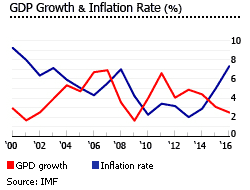
The Colombian economy expanded by 3.1% in 2015, a slowdown from 4.4% growth in 2014, 4.9% in 2013, according to the International Monetary Fund (IMF). This weak performance was expected, since oil is one of Colombia's main exports.
The export decline also caused the Colombian peso's devaluation. In February 2016, the currency reached a historic low of around COP 3,400 per USD, having lost about 28% of its value over the past 12 months.
Scotiabank predicts that the COP will stay within the 3,000 to 3,300 range, but will depend on external factors such as USA's monetary policy normalization, China's financial woes, and the instability of oil prices.
Colombia's GDP rose by 2.5% during the year to Q1 2016, its lowest growth rate since the global financial crisis of 2009.

According to the IMF, the Latin American region "will grow slowly for an extended period of time".
"The region continues to be particularly vulnerable for a stronger slowdown as the one foreseen for China — one of the most important trade partners in the region — and the new drops in commodity prices," based on the regional forecast of IMF’s Latin America chief Alejandro Werner.
From 2003 to 2008, the country had robust economic growth averaging 5.2% per year, but growth slowed sharply in 2009 to 1.7%, before returning to 4% in 2010, and 6.6% in 2011.
In June 2016, annual inflation rose to 8.6%, more than double than the central bank's +/- 1 percentage point around the 3% target.
Unemployment in Colombia fell to 8.8% in May 2016, slightly down from 8.9% in May 2015.
Housing deficit falling; housing initiatives
Like many 3rd world countries Colombia measures its "housing deficit", i.e., the proportion of households either poorly housed, or not housed at all. Colombia's housing deficit has fallen to only around 1,647,093 units in 2012, or around 27% of households, according to research by the Banco Bilbao Vizcaya Argentaria (BBVA).
In 2005, the housing deficit had been 2.4 million housing units. But by 2012 only 5.5% of all households did not have a home, down from 12.6% in 2005, and only 10.9% of all households lived in sub-standard housing, down from 14.4% in 2005.
During Santos' 1st term housing further initiatives were launched, aiming to build 1 million houses from 2010 to 2014. Much was achieved through subsidizing low-income families' home purchases, as well as building free homes.
The two main programmes were:
- Priority Interest Housing (Vivienda de Interés Prioritario, VIP)
- Social Interest Housing (Vivienda de Interés Social, VIS)
The VIP programme, introduced in 2012, provided 100,000 free homes to the poorest, beneficiaries registered with the Administrative Department for Social Prosperity.
The VIS programme, implemented April 2013, offers subsidies to low-income families. To qualify for VIS, families' monthly incomes must not exceed four times the minimum wage (or around US$ 1,360). Houses for the VIS programme are undertaken by private developers.
Other government housing programmes include:
- Vivienda para Ahorradores (Homes for Savers) wherein buyers get subsidies for down payments as well as interest payments (the government decides which residential developments are eligible)
- National Savings Fund (Fondo Nacional del Ahorro, FNA), which provided access to loans
- Stimulus Plan for Production and Employment (Plan de Impulso a la Productividad y el Empleo, PIPE), which subsidises mortgaged properties priced from COP 80 million (US$ 31,296) to COP 198 million (US$ 77,459).
In December 2014, a new programme was launched to help middle-income Colombian home buyers (with incomes between two to four times the official minimum wage). Called "Mi Casa Ya" (My House Now), the program is scheduled to last from January 2015 to January 2018. It consists of a subsidy worth COP 12 million (US$ 4,094) for a home's down payment, and also a subsidy of four percentage points on the mortgage interest rate, reducing the interest rate from 12.5% to 8.5%.
The purchased home's value should be more than 70 minimum monthly salaries or around COP 48,261,850 (US$ 16,466) but not exceeding 135 minimum monthly salaries or around COP 93,076,425 (US$ 31,755).
Around 130,000 families are expected to benefit from this program between 2015 and 2018, according to Colombia's Ministry of Housing, City and Territory.